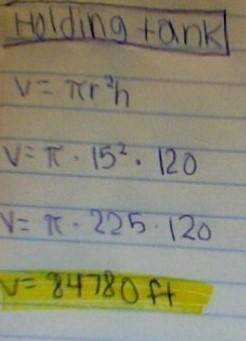 1
1 a). Radius r of the small sector= 12cm
b). Perimeter of the shape= 68 cm
c). Angle= 47.7°
Step-by-step explanation:
a). Radius of the big sector= 24 cm
Arc if the big sector= 20 cm
Arc of the small sector= 10 cm
For the radius r of the small sector
r/10 = 24/20
r=(10*24)/20
r= 24/2
r= 12 cm
Radius r of the small sector= 12cm
b). Perimeter of the shape
= Total length of the shape
Let's note that the other side of the sector is also the radius= 24 cm
Perimeter= 20+24+24
Perimeter of the shape= 68 cm
c) the angle
Length of arc = 2πr*(angle/360)
Let angle = b
Length of arc = 20cm
20= 2*3.14*24*(b/360)
(20*360)/(2*3.14*24)= b
47.7°= b
Angle= 47.7°
 1
1 a). Radius r of the small sector= 12cm
b). Perimeter of the shape= 68 cm
c). Angle= 47.7°
Step-by-step explanation:
a). Radius of the big sector= 24 cm
Arc if the big sector= 20 cm
Arc of the small sector= 10 cm
For the radius r of the small sector
r/10 = 24/20
r=(10*24)/20
r= 24/2
r= 12 cm
Radius r of the small sector= 12cm
b). Perimeter of the shape
= Total length of the shape
Let's note that the other side of the sector is also the radius= 24 cm
Perimeter= 20+24+24
Perimeter of the shape= 68 cm
c) the angle
Length of arc = 2πr*(angle/360)
Let angle = b
Length of arc = 20cm
20= 2*3.14*24*(b/360)
(20*360)/(2*3.14*24)= b
47.7°= b
Angle= 47.7°
 9
9 The radius will be smaller than the radius of the sphere
The volume of the 2 pieces of the sphere will not be the same
Step-by-step explanation:
A sphere is a three-dimensional geometrical figure. It is a set of all points equidistant from a fixed point in space.
A circle is a two-dimensional figure. It is the locus of all points equidistant from a central point.
For a circular cross-section of a sphere that does not pass through the center,
the radius will be smaller than the radius of the sphere, the volume of the 2 pieces of the sphere will not be the same
 9
9 The radius will be smaller than the radius of the sphere
The volume of the 2 pieces of the sphere will not be the same
Step-by-step explanation:
A sphere is a three-dimensional geometrical figure. It is a set of all points equidistant from a fixed point in space.
A circle is a two-dimensional figure. It is the locus of all points equidistant from a central point.
For a circular cross-section of a sphere that does not pass through the center,
the radius will be smaller than the radius of the sphere, the volume of the 2 pieces of the sphere will not be the same

Explanation:
We know that relationship between fatigue and stress concentration factor

Where
 =fatigue concentration factor
=fatigue concentration factor
 =stress concentration factor
=stress concentration factor
q=Notch sensitivity
Here D/d=2 and r/d=0.125
Now from standard design data book 
For Sut=440 MPa and r= 4 mm
q=0.8
Now by putting the values




Explanation:
We know that relationship between fatigue and stress concentration factor

Where
 =fatigue concentration factor
=fatigue concentration factor
 =stress concentration factor
=stress concentration factor
q=Notch sensitivity
Here D/d=2 and r/d=0.125
Now from standard design data book 
For Sut=440 MPa and r= 4 mm
q=0.8
Now by putting the values



Step-by-step explanation:
did u know fifteen minutes could save you fifteen percent or more on car insurance.

Step-by-step explanation:
did u know fifteen minutes could save you fifteen percent or more on car insurance.

see the attached pictures
Step-by-step explanation:



 2
2 a. radius = 0.0006m = 0.6mm and length =0.393m = 393mm
b. frequency =377.86Hz
Explanation:
Given:
mass of steel= 4g = 0.004kg
density of steel = 7890kg/m3
tensile stress of steel 7.0x10⁸
tension load =900N
from the density, we will calculate for the Volume of the steel string
density = mass/volume
volume = mass/density = 0.004/7890 = 5.07 x 10⁻⁷ m³
from the tensile stress will can get the maximum base Area of the string ,
tensile stress = load/area =
7x10⁸ = 900/A
A = 900/7x10⁸ = 1.29x10⁻⁶ m²
Area = πr²
area/pi = 4.105x10-7
radius = 0.0006m = 0.6mm
volume = Area x length
length = vol/area =(5.07 x 10⁻⁷ m³)/1.29x10⁻⁶ m² = 0.393m
b. the highest possible frequency is given by:
F = 
where T= tension, m=mass, L=length
F = 
= 297.04/0.786
frequency =377.86Hz

It will provide an instant answer!
